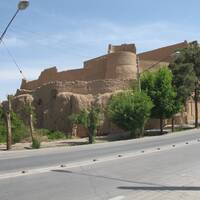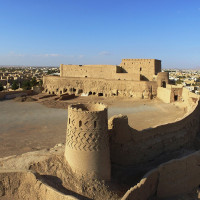
Narin Qaleh (Castle)
Narin Qaleh (Castle) (Persian: نارین قلعه), known among the people of Meybod, Yazd as Naranj Qala, like other castles, is the center part of the city. Living in the Meybod city dates back to seven thousand years. The existence of Narin Qaleh in the late fourth millennium BC is proof of this claim. The castle is located in an irregular elliptical shape on a hill 25 meters high in about 4 hectares with five gates. It enjoys wide and long ditches, towers, and fences, up to 6 of them. The castle is built on five floors which are separated by walls and fences.
Its long history has given it a legendary identity; for example, it has attributed to the time of Solomon. It is referred to as the "White Demon Fortress" of the Shahnameh, but archaeologists excavated the fort and found pottery dating back to the Iron Age and the Median period. As a result, it is known as a fortress used for centuries, during the Achaemenid, Parthian, Seleucid, and Sassanid periods, even after Islam. It was also regularly repaired, so we are faced with a structure that is still standing after centuries.
Some scholars consider the castle to be a religious center and temple due to its ziggurat structure. Archaeologists do not reject this hypothesis, but the presence of thick walls, watchtowers, buildings, wide ditches, and the complete aristocracy of the castle on the adjacent plains has made it a military-governmental fortress. They could defend it when the enemies attacked.
The castle is made of clay and mud, materials that are native to the region.
A large and wide moat was built around the fence, which unfortunately was destroyed by the construction of a street in 1961. In the southern part of the castle, there are spaces carved in the heart of the earth that archaeologists date back to the Median period. It was considered a kind of primitive housing in the Median period. Another sight of this castle is a square well with many legends; Some say it is known as the burial place of the treasures of the ancestors, and some believe it is referred to as a dungeon.
The Shahneshin, which was the residence of the rulers of the time, is one-story. However, the three floors are intertwined. It is the oldest building of the castle with rooms at the beginning of the entrance that was the warehouse and storage of food. This Shahneshin has a porch on the top floor of the castle with the view of the city, known as the Shahneshin porch.



